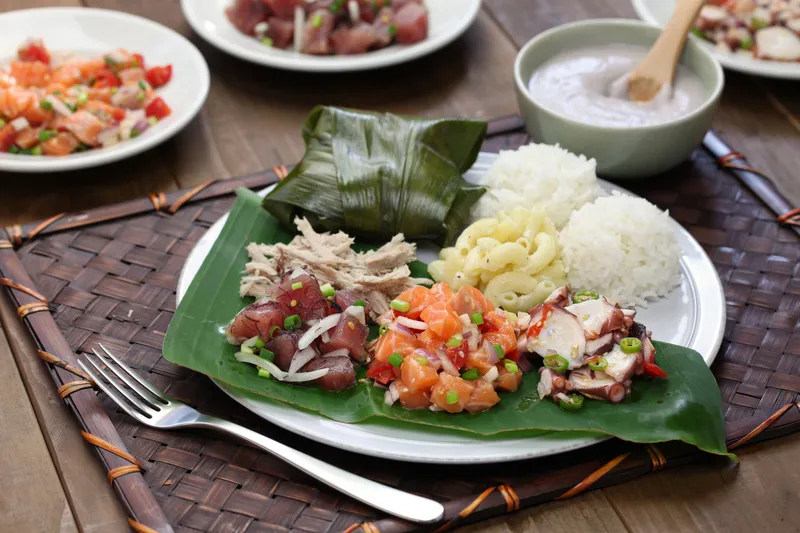

Three Culinary Worlds
Native traditions, plantation fusion, and modern innovation - understanding Hawaiian food styles

Written by a Culinary Expert
Jade KawanuiSpeaking the Language of Food
Food terminology in Hawaiʻi can confuse visitors. Is a plate lunch "Hawaiian food"? What's the difference between local drive-in dishes and high-end resort fare?
Understanding three primary culinary styles—Native Hawaiian, "Local Food," and Hawaiʻi Regional Cuisine—is key to navigating our rich gastronomic landscape. These categories represent different aspects of Hawaiʻi's identity at various historical points.
Each culinary style tells a different chapter of our story—from ancient spiritual connections to land, to immigrant resilience, to modern culinary innovation that honors both.
Native Hawaiian Food: The Original Cuisine
Native Hawaiian food is our ancestral cuisine—food of indigenous people rooted in canoe plants and ingredients available before Western contact. This style relies on fresh, natural ingredients and traditional preparation methods, especially the imu. Flavors are often earthy, clean, and smoky. It's our culinary bedrock.

Key Dishes
- • Kalua pig (imu-roasted pork)
- • Laulau (pork wrapped in taro leaves)
- • Poi (pounded taro)
- • Traditional poke (simple seasonings)
- • Kulolo (taro-coconut pudding)
Characteristics
- • Uses only pre-contact ingredients
- • Prepared with traditional methods
- • Earthy, smoky flavors from imu
- • Deep spiritual significance
- • Focus on natural ingredients
🍽️ Three Food Styles
- Native HawaiianPre-contact traditional
- Local FoodPlantation-era fusion
- Regional CuisineModern fine dining
📍 Where to Find
Lūʻau, cultural centers
Drive-ins, plate lunch shops
Fine dining restaurants
🔗 Explore More
"Local Food": The Heartbeat of the Islands
"Local Food" is delicious, democratic, deeply comforting fusion cuisine born in the plantation era. It results from over a century of cultural exchange—organic evolution as Chinese, Japanese, Portuguese, Filipino, and other immigrant workers shared meals and culinary traditions.
This is everyday food of Hawaiʻi, found at family gatherings, drive-ins, and local diners statewide. It's hearty, flavorful, and represents the true multicultural soul of modern Hawaiʻi.
Iconic Dishes
- • Plate lunch (rice, mac salad, entree)
- • Loco moco (hamburger, rice, gravy, egg)
- • Saimin (local-style ramen)
- • Spam musubi
- • Manapua (Chinese steamed bun)
- • Shave ice
Cultural Influences
- • Japanese (shoyu, bento boxes)
- • Chinese (rice, stir-fry, char siu)
- • Portuguese (malasadas, sweet bread)
- • Filipino (adobo, lumpia)
- • Korean (kimchi, barbecue)
- • Puerto Rican (pasteles)
Local food is where cultures met and magic happened. It's the delicious proof that when people share meals, they share hearts, creating something entirely new while honoring what came before.
Hawaiʻi Regional Cuisine: A Culinary Revolution
Hawaiʻi Regional Cuisine isn't ancient tradition but a modern culinary movement, founded intentionally in 1991 by twelve visionary chefs. Frustrated with poor-quality hotel food relying heavily on frozen, imported mainland ingredients, these chefs sparked revolution.
HRC's core philosophy creates sophisticated, world-class dishes using the freshest, locally sourced island ingredients—from cattle raised on upland pastures and vegetables grown in rich volcanic soil to the world's highest-quality fish.
The Founding Twelve
The twelve founding chefs—Sam Choy, Roger Dikon, Mark Ellman, Amy Ferguson Ota, Beverly Gannon, Jean-Marie Josselin, George Mavrothalassitis, Peter Merriman, Philippe Padovani, Gary Strehl, Alan Wong, and Roy Yamaguchi—put Hawaiʻi on the international culinary map.
Local Ingredients
Fresh island-grown produce, locally raised meats, and the world's best seafood caught in Hawaiian waters.
Global Techniques
Sophisticated cooking methods blended with diverse ethnic flavors already present in Hawaiian culture.
Innovation
Creating new, distinctly modern fusion cuisine that honors tradition while pushing culinary boundaries.
Hawaii Regional Cuisine elevated our islands from tourist destination to culinary destination—proving that Hawaii's ingredients and flavors deserve a place on the world's finest tables.

